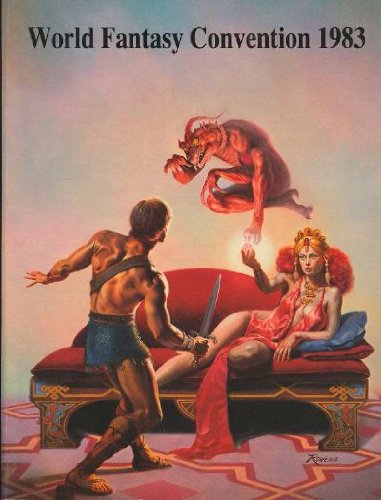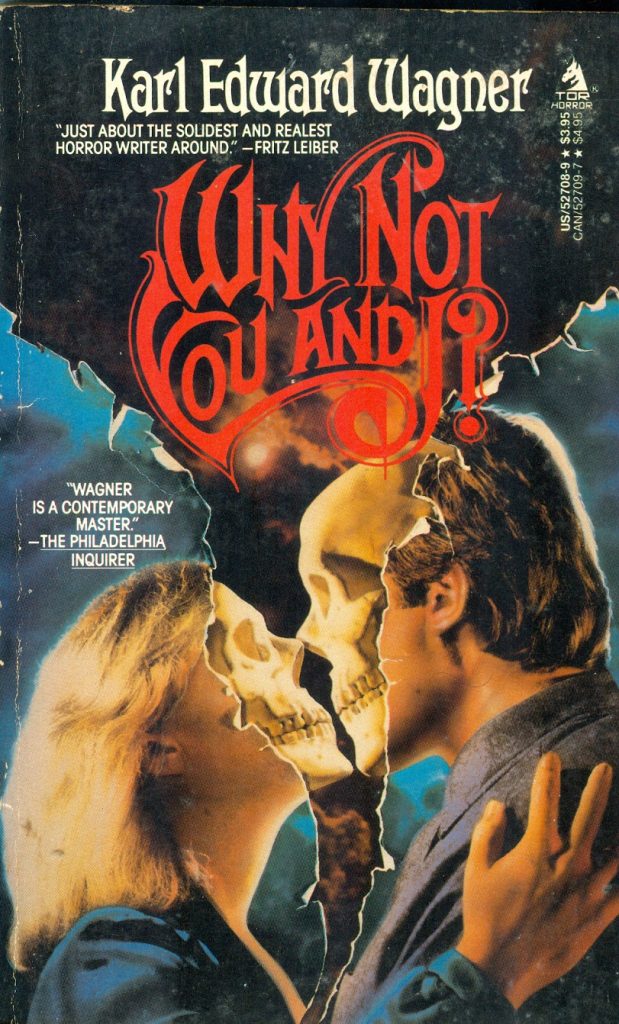 Karl Edward Wagner’s story, “Neither Brute nor Human” to me, is one of the best satires on fantasy publishing that I have ever read. The story originally published in the World Fantasy Convention Program Book for 1983. ISFDB.org page has a question mark as to whether it is trade paperback size or not. I have the 1982 booklet which is 8.5 x 11 inches and saddle stapled.
Karl Edward Wagner’s story, “Neither Brute nor Human” to me, is one of the best satires on fantasy publishing that I have ever read. The story originally published in the World Fantasy Convention Program Book for 1983. ISFDB.org page has a question mark as to whether it is trade paperback size or not. I have the 1982 booklet which is 8.5 x 11 inches and saddle stapled.
Robert Weinberg edited the program book. It is listed as having 96 pages and price as $8.95 ($22.11 in today’s dollars). The cover by Rowen Morrill. The theme is a celebration of Weird Tales magazine. Included are essays by Karl Edward Wagner, Algis Budrys, Robert Weinberg, Stephen King, Robert Bloch, Jack Williamson, Sam Moskowitz. Fiction by Gene Wolfe, Manly Wade Wellman, Ramsey Campbell, Hugh B. Cave, Philip Jose Farmer, Brian Lumley, and Karl Edward Wagner. Talk about giants walking in those days. This should be reprinted as a mass market paperback.
Karl Edward Wagner new fiction was infrequent in the early 1980s. Warner Books had reprinted the Kane books in spring 1983. I bought each of them off the shelf. There was a follow up collection, In a Lonely Place in July 1983, which I liked a lot.
I did not read “Neither Brute Nor Human” until October 1987 when it was reprinted in the Tor paperback, Why Not You and I? I had just read some of the contents in Night Visions: Dead Image (Berkley Books, September 1987) a few weeks before seeing Why Not You and I?
“Neither Brute Nor Human” is the tale of two writers, Damon Harrington and Trevor Nordgren who first meet at Discon 1974. Harrington is a writer of fantasy, Nordgren writes horror. Nordgren has written a handful of novels under pseudonyms including porn. Harrington almost had a post-apocalyptic novel Iron Night published by Powell Books.
Nordgren makes a splash with a horror novel titled Out of the Past. Two years later, Nordgren and Harrington meet at the Second World Fantasy Convention.
“Fairlane had contributed two dozen copies of Iron Night, free to the first lucky autograph seekers, so for about fifteen minutes Harrington was kept busy. He grew tired of explaining to unconcerned fans that the novel was set in a post-nuclear holocaust future, and that it was not at all ‘In the Conan Tradition!’ as the cover proclaimed.”
Nordgren becomes a famous author of novels with titles as The Sending and The Rending. Harrington’s publisher Fairland Books declares bankruptcy owing most of the royalties for the Desmond Killstar series. He bounces back:
“Death’s Dark Mistress, the first of the Krystel Firewind novels, was good for a quick five-grand advance and a contract for two more over the next year. The paperback’s cover was a real eye-catcher, displaying Krystel Firewind astride her flying dragon and brandishing her enchanted broadsword at a horde of evil dwarves….Damon was less pleased with the cover blurb that proclaimed him ‘America’s Michael Moorcock’.”
A few years earlier, Harrington had been called “our new Robert E. Howard.” Meanwhile, Trevor Nordgren received a two million dollar advance for paperback rights to The Etching.
At New Orleans (“Cajun-con”) in 1979, the two engage in cocaine, Columbian, and Thai stick. Nordgren is feeling the strain and self-medicating:
“ ‘Coke’s been my salvation. I feel better. I write better. It’s all the psychic energy I’m drawing in from all those millions of reader out there’.”
Nordgren has short story collections, non-fiction collections, uniform editions, and movie adaptations.
Fantasy publishing is undergoing changes:
“Julie Kriegman was fired by the new corporate owners of Summit Books, and the new editor called Krystel Firewind sexist trash and killed the series with #5.”
Damon’s editor has an idea:
“It doesn’t look good. Problem is that every paperback house that wants to already has one or two swords-and-sorcery series going. Do you think you could write high fantasy? That’s getting to be big just now. You know–lighten up a little on the violence and bare tits, give your imaginary world more of a fairy-tale atmosphere, maybe link in a bunch of Celtic myths and that sort of thing’.”
“Harrington read over a few popular works on Celtic mythology and ancient European history to get some names and plot ideas, then started the rewrite of Krystel Firewind #6. This he was able to flesh out into a trilogy without much difficulty by basing his overall theme on the struggle of Roman Britain against the Saxon invasions. After her sex-change from Desmond Killstar, it was simple enough to transform Krystel Firewind into a half-elfin Druidic priestess.”
Columbine Books loves Tallyssa’s Quest: Book One of the Fall of the Golden Isles.”
“Tallyssa’s Quest was launched with a major promotional campaign, complete with dump bins and color posters of the book’s cover. The cover, a wraparound by some Italian artist, was a rather ethereal thing depicting a billowingly berobed Tallyssa astride her flying unicorn and brandishing her Star of Life amulet to defend her elfin companions from a horde of bestial Kralkings. Harrington would much rather the cover hadn’t billed him as ‘The New Tolkien,’ but Columbine had paid him his first five-figure advance.”
Columbine Books of course is Ballantine or rather the Del-Rey line. Summit Books is Ace.
Nordgren is a cocaine snorting burnout. He is very agitated:
“But we somehow write what the public wants from us instead. Or do you get off by being followed about by teenage fans in farcical medieval drag with plastic pointy ears and begging to know whether Wyndlunne the Fey is going to be rescued from Grimdoom’s Black Tower in Book Four of the Trilogy of Triologies!”
Wagner even slips in a reference to The Other Woman, a porn novel written earlier in this career. Nordgren ends up dying from heart failure from drug use or an out and out drug overdose. Harrington stops writing and becomes a recluse.
In this story, the reader gets a mini-history of fantasy publishing from the late 1970s through the early 1980s with the trend from sword and sorcery to derivative high fantasy. Who is Trevor Nordgren? He appears to be based on Stephen King with some elements of Harlan Ellison. Harrington of course is Karl Edward Wagner. There is an annoying fan with a few stories in the small press, Martin E. Binkley who gets himself on a convention panel with Harrington and Nordgren. Who was Martin E. Binkley?
“Neither Brute Nor Human” won a British Fantasy Award in 1984 in the best short fiction category.
Wagner did not become a recluse but he never produced In the Wake of the Night, Silver Dagger, The Fourth Seal, At First Just Ghostly etc. There is a phantom bookshelf of unwritten Karl Edward Wagner books.
The story has an unease about the price of fame and fan worship. It is a sort of Syd Barrett-Julian Cope type thing going on. He was pretty caustic in his column in the pages of Fantasy Newsletter at this time. I think the story has some great moments of satire. Steve Tompkins and I used the term “Desmond Killstar” as shorthand for post-apocalyptic settings. I have said more than once listed Damon Harrington on online discussion groups when asked for favorite authors. In fact, I have added to his fictional bibliography with two unauthorized Conan pastiches from Carousel Books that were suppressed by L. Sprague de Camp in the late 1970s.
Wagner got in some good digs at horror and fantasy publishing of the day. If he could only see what it is like today.

Ah, the cover to BLUE ADEPT. Good ole Piers Anthony. Great post.
If alcohol and drugs hadn’t eaten up Wagner, we would have had some great weird stories. As it was he was mostly good to great. Darkness Weaves was great as was Bloodstone.